|
|
Post by Rockoonz on Feb 26, 2018 1:00:52 GMT -5
woodman I will ask at the club meeting tomorrow, and I plan to be at the TV club show on Friday the 9th.
|
|
Tommy
Administrator 
Member since January 2013
Posts: 12,993
|
Post by Tommy on Feb 26, 2018 12:32:16 GMT -5
I just now now updated the original post with pictures of the drain installation and a video of the finished operation. MsAli just to make you feel better my bloody thumb is on display in the video  It happens to the best of us - happens to me WAY too often haha. |
|
|
|
Post by MsAli on Feb 26, 2018 14:01:43 GMT -5
I just now now updated the original post with pictures of the drain installation and a video of the finished operation. MsAli just to make you feel better my bloody thumb is on display in the video  It happens to the best of us - happens to me WAY too often haha. Now I don't feel so bad 
Its amazing how fast it happens and how dang bad it hurts
|
|
jamesp
Cave Dweller 
Member since October 2012
Posts: 36,612
|
Post by jamesp on Mar 2, 2018 6:37:43 GMT -5
Help Tommy please sir. Got questions. Need 8 inch lap. Will build or buy used or modify/fix up old unit. I have the 60/280/600/1500 diamond blades, they are 1mm thick/200mm diameter and have a 12.7mm/1/2" hole in the center. Electro-diamond one side only. I have no backing plate, I have nothing. Just the blades. I assume you change blades like you change records on a record player. I want to be able to change blades in a jiffy. I see 8 inch aluminum backing plates with same 1/2 inch center hole, but no way to clamp to 1/2 inch shaft  I have a 1000 RPM 1/6HP motor, would like to spin blade at 600 to 800 RPM not that that matters so much. That is just ratio stuff, I can figure that part. Got a 12 inch fire pit bowl 1/8" thick and about 4 inches deep. I can weld drains and feed plumbing fittings directly to it. It takes welds fine. Even motor mount and legs and the peripherals like a lamp can be welded to it. It is shaped exactly like this fire pit with out the pedestal base. It is simply an elliptical end cap to a 12 inch compressor tank: 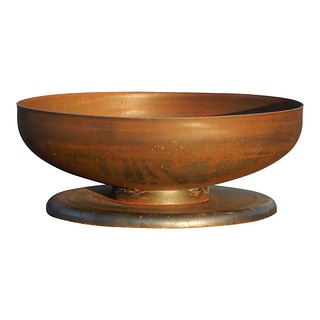 I see a need for a 1/2 inch shaft sticking up thru the center to slide the grinding discs down on to that backing plate. What does the backing plate attach to ? A backing plate for the backing plate ? Do you use a 1/2 inch ID clamping collar to hold the blade down on the backing plate ? Or does 1/2 inch shaft need to be threaded ? what is the difference in these 2 laps ? Is this my target design ? 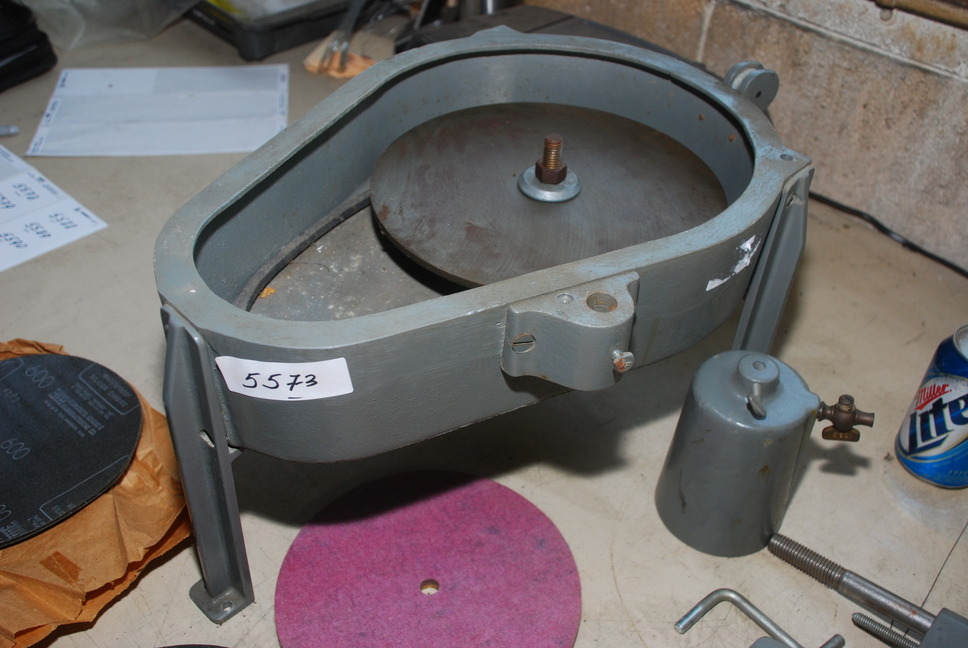 I could buy this but it has no vertical 1/2 inch shaft sticking up and looks like it would sling water:  I believe this is what I need to mimic, it looks like the brass collar w/set screw holds the grinding plate down on the backing plate: 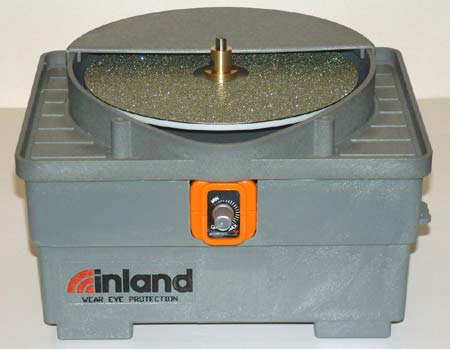 Thanks for any help I can get. I suppose I should go ahead and order an aluminum backing plate too. Mlyuns of questions, sorry. |
|
|
|
Post by Drummond Island Rocks on Mar 2, 2018 7:15:02 GMT -5
Help Tommy please sir. Got questions. Need 8 inch lap. Will build or buy used or modify/fix up old unit. I have the 60/280/600/1500 diamond blades, they are 1mm thick/200mm diameter and have a 12.7mm/1/2" hole in the center. Electro-diamond one side only. I have no backing plate, I have nothing. Just the blades. I assume you change blades like you change records on a record player. I want to be able to change blades in a jiffy. I see 8 inch aluminum backing plates with same 1/2 inch center hole, but no way to clamp to 1/2 inch shaft  I have a 1000 RPM 1/6HP motor, would like to spin blade at 600 to 800 RPM not that that matters so much. That is just ratio stuff, I can figure that part. Got a 12 inch fire pit bowl 1/8" thick and about 4 inches deep. I can weld drains and feed plumbing fittings directly to it. It takes welds fine. Even motor mount and legs and the peripherals like a lamp can be welded to it. It is shaped exactly like this fire pit with out the pedestal base. It is simply an elliptical end cap to a 12 inch compressor tank:  I see a need for a 1/2 inch shaft sticking up thru the center to slide the grinding discs down on to that backing plate. What does the backing plate attach to ? Do you use a 1/2 inch ID clamping collar to hold the blade down on the backing plate ? Or does 1/2 inch shaft need to be threaded ? what is the difference in these 2 laps ? Is this my target design ? I could buy this but it has no vertical 1/2 inch shaft sticking up and looks like it would sling water: I believe this is what I need to mimic, it looks like the brass collar w/set screw holds the grinding plate down on the backing plate: Thanks for any help I can get. I suppose I should go ahead and order an aluminum backing plate too. I have had several flat laps like the ones in your pictures and still have a couple I use but they are a different model. The 8" backing plate just sits on a flange that is mounted to the shaft. You slide the diamond laps with the 1/2" hole down on top then add the top flange and tighten down the nut. Pretty much holds it all together the same as mounted a blade on a saw. The one in your first picture originally had a vise attachment option and was used to gravity feed a rock into a saw blade. Chuck |
|
|
|
Post by Drummond Island Rocks on Mar 2, 2018 7:27:58 GMT -5
These are my favorites. Gemlap brand that was made just a few miles from where I live back in the 60's. Might give you more ideas for your build. I built the stand a few years back   This shows the bottom flange that the steel plate rests on 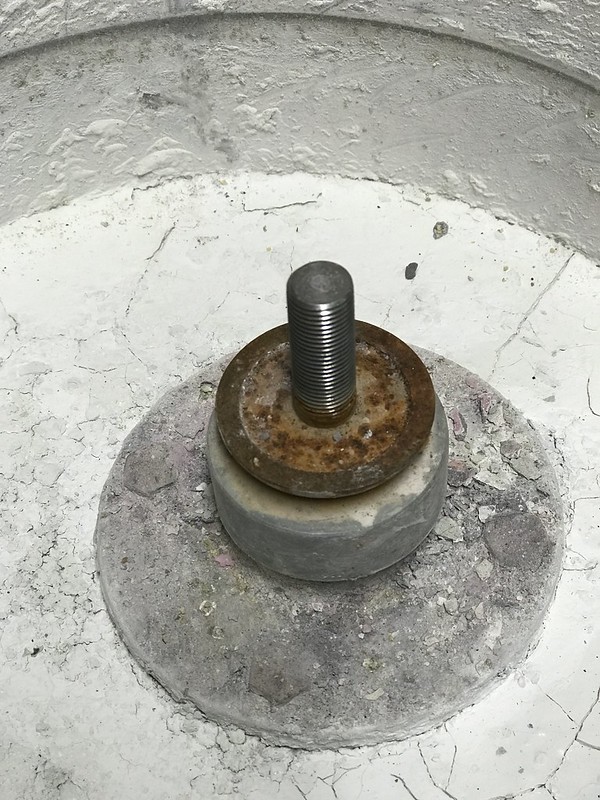 |
|
jamesp
Cave Dweller 
Member since October 2012
Posts: 36,612
|
Post by jamesp on Mar 2, 2018 7:37:28 GMT -5
"The 8" backing plate just sits on a flange that is mounted to the shaft. You slide the diamond laps with the 1/2" hole down on top then add the top flange and tighten down the nut. Pretty much holds it all together the same as mounted a blade on a saw." Very good Drummond Island Rocks. This answers the most of my questions. Plain and simple. Great analogy using the saw blade arrangement. I get it loud and clear. "I have had several flat laps like the ones in your pictures and still have a couple I use but they are a different model. Tell me why you have several ? You have a fine unit mounted in the dungeon work shop table. Is this the lap of your choice ? Let me know if you want to sell one of several...What speed do you like to operate at ?(It will be used on softer glass so slower seems better) I am using it similar to the reason Tommy is using it, to dress the back side of glass cabs. Except I will be removing 1/16" to 1/8" glass off the back with a 60 grit wheel. Then to finer grits. |
|
jamesp
Cave Dweller 
Member since October 2012
Posts: 36,612
|
Post by jamesp on Mar 2, 2018 7:41:01 GMT -5
These are my favorites. Gemlap brand that was made just a few miles from where I live back in the 60's. Might give you more ideas for your build. I built the stand a few years back   This shows the bottom flange that the steel plate rests on  Excellent photos of construction Chuck. These are very helpful. The water feed reservoir is cat's meow. This closes out my unanswered questions Tommy. Thanks much Chuck. Tommy still in bed snoring. |
|
jamesp
Cave Dweller 
Member since October 2012
Posts: 36,612
|
Post by jamesp on Mar 2, 2018 7:43:51 GMT -5
Big help is this photo Drummond Island Rocks. The rest is fairly self explanatory. ETA Looks too dirty to be a Drummond machine. kidding, I know why it is dirty. I like the idea of the shaft being offset from the lowest point in the bowl for water drainage. I suppose you use just enough water to keep the abrasive plate damp.  |
|
|
|
Post by Drummond Island Rocks on Mar 2, 2018 7:57:36 GMT -5
"The 8" backing plate just sits on a flange that is mounted to the shaft. You slide the diamond laps with the 1/2" hole down on top then add the top flange and tighten down the nut. Pretty much holds it all together the same as mounted a blade on a saw." Very good Drummond Island Rocks. This answers the most of my questions. Plain and simple. Great analogy using the saw blade arrangement. I get it loud and clear. "I have had several flat laps like the ones in your pictures and still have a couple I use but they are a different model. Tell me why you have several ? You have a fine unit mounted in the dungeon work shop table. Is this the lap of your choice ? Let me know if you want to sell one of several...What speed do you like to operate at ?(It will be used on softer glass so slower seems better) I am using it similar to the reason Tommy is using it, to dress the back side of glass cabs. Except I will be removing 1/16" to 1/8" glass off the back with a 60 grit wheel. Then to finer grits. I have bought and sold a few like the ones in your photos with the saw attachments. I have three of these gemlap units right now. The one in the photos I use for lapidary work. The second one is mounted on a similar stand and is currently modified to be a bowling ball spinner. The third one is in the attic as a spare. Chuck |
|
|
|
Post by Drummond Island Rocks on Mar 2, 2018 7:59:35 GMT -5
Big help is this photo Drummond Island Rocks. The rest is fairly self explanatory. ETA Looks too dirty to be a Drummond machine. kidding, I know why it is dirty. I like the idea of the shaft being offset from the lowest point in the bowl for water drainage. I suppose you use just enough water to keep the abrasive plate damp.  Been working on a bunch of Petoskey stones lately. That would be limestone mess. Normally the flat lap is way more colorful since I use it to flatten the backs of fordite rough before cabbing. Chuck |
|
jamesp
Cave Dweller 
Member since October 2012
Posts: 36,612
|
Post by jamesp on Mar 2, 2018 8:37:11 GMT -5
"The 8" backing plate just sits on a flange that is mounted to the shaft. You slide the diamond laps with the 1/2" hole down on top then add the top flange and tighten down the nut. Pretty much holds it all together the same as mounted a blade on a saw." Very good Drummond Island Rocks. This answers the most of my questions. Plain and simple. Great analogy using the saw blade arrangement. I get it loud and clear. "I have had several flat laps like the ones in your pictures and still have a couple I use but they are a different model. Tell me why you have several ? You have a fine unit mounted in the dungeon work shop table. Is this the lap of your choice ? Let me know if you want to sell one of several...What speed do you like to operate at ?(It will be used on softer glass so slower seems better) I am using it similar to the reason Tommy is using it, to dress the back side of glass cabs. Except I will be removing 1/16" to 1/8" glass off the back with a 60 grit wheel. Then to finer grits. I have bought and sold a few like the ones in your photos with the saw attachments. I have three of these gemlap units right now. The one in the photos I use for lapidary work. The second one is mounted on a similar stand and is currently modified to be a bowling ball spinner. The third one is in the attic as a spare. Chuck A man needs his machines, where would we be in this business without them ? No surprise you have dedicated uses doing so many different materials. Hey, just so you can see this metal stamping. It is actually 14 inches in diameter, 4" deep. 1/8" carbon steel. Easy to weld peripherals to as it is structurally very strong like legs/dripper container/motor or pulley mounting plate/water color for shaft through hole/lamp and whatever. 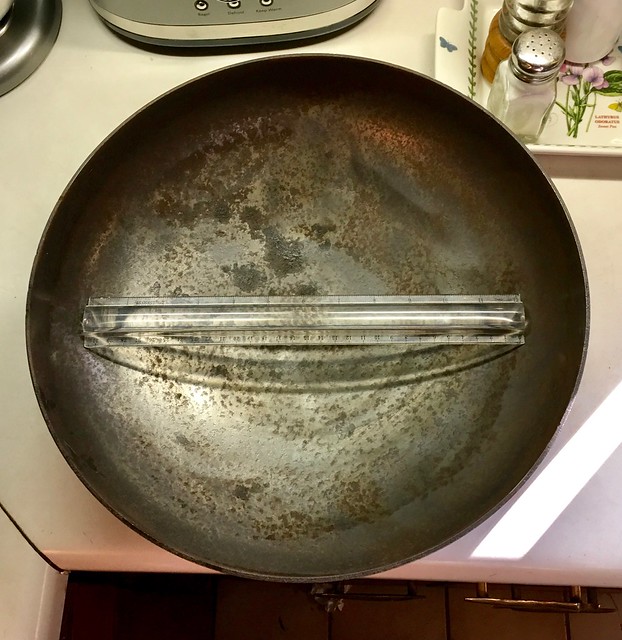 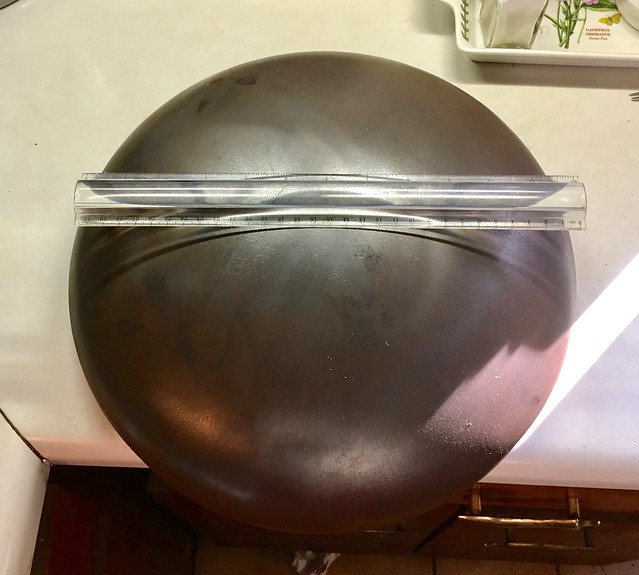 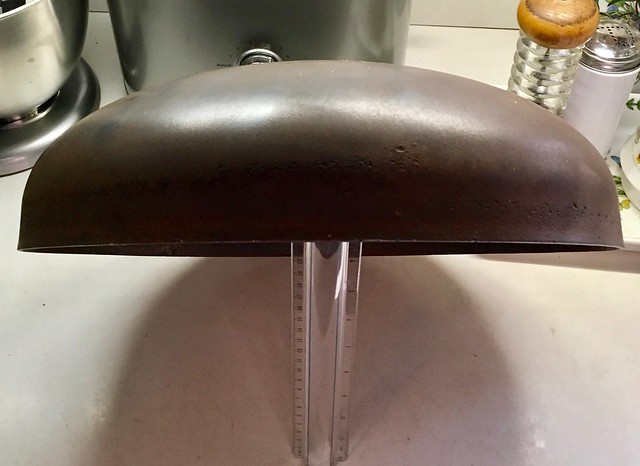 |
|
|
|
Post by MrP on Mar 2, 2018 8:42:25 GMT -5
"The 8" backing plate just sits on a flange that is mounted to the shaft. You slide the diamond laps with the 1/2" hole down on top then add the top flange and tighten down the nut. Pretty much holds it all together the same as mounted a blade on a saw." Very good Drummond Island Rocks . This answers the most of my questions. Plain and simple. Great analogy using the saw blade arrangement. I get it loud and clear. "I have had several flat laps like the ones in your pictures and still have a couple I use but they are a different model. Tell me why you have several ? You have a fine unit mounted in the dungeon work shop table. Is this the lap of your choice ? Let me know if you want to sell one of several...What speed do you like to operate at ?(It will be used on softer glass so slower seems better) I am using it similar to the reason Tommy is using it, to dress the back side of glass cabs. Except I will be removing 1/16" to 1/8" glass off the back with a 60 grit wheel. Then to finer grits. James I think you will find that the 60 grit will badly chip the glass. I find that if you go from the edge into the center you can somewhat get away with using the more aggressive wheel because you will be working the top any way. If you put the cab flat on the disk the following edge will end up chipped. I use an 80 grit if I have a lot to remove but that even chips more then I like. If you are getting anywhere close to where you want to be use a 100 grit. Just my opinion so take it for what it is worth.....................MrP |
|
jamesp
Cave Dweller 
Member since October 2012
Posts: 36,612
|
Post by jamesp on Mar 2, 2018 9:48:40 GMT -5
"The 8" backing plate just sits on a flange that is mounted to the shaft. You slide the diamond laps with the 1/2" hole down on top then add the top flange and tighten down the nut. Pretty much holds it all together the same as mounted a blade on a saw." Very good Drummond Island Rocks . This answers the most of my questions. Plain and simple. Great analogy using the saw blade arrangement. I get it loud and clear. "I have had several flat laps like the ones in your pictures and still have a couple I use but they are a different model. Tell me why you have several ? You have a fine unit mounted in the dungeon work shop table. Is this the lap of your choice ? Let me know if you want to sell one of several...What speed do you like to operate at ?(It will be used on softer glass so slower seems better) I am using it similar to the reason Tommy is using it, to dress the back side of glass cabs. Except I will be removing 1/16" to 1/8" glass off the back with a 60 grit wheel. Then to finer grits. James I think you will find that the 60 grit will badly chip the glass. I find that if you go from the edge into the center you can somewhat get away with using the more aggressive wheel because you will be working the top any way. If you put the cab flat on the disk the following edge will end up chipped. I use an 80 grit if I have a lot to remove but that even chips more then I like. If you are getting anywhere close to where you want to be use a 100 grit. Just my opinion so take it for what it is worth.....................MrP Dang Michael, some of this glass has 1/2 inch thick clear glass(some even more) on the front and 1/2 inch white glass on back I have to remove till I get the color layer located in the sweet spot. Most of this grinding will take place before the melt. It is like extracting the color out of a small paper weight. These are not shards but color rich knock-offs during the blowing process and I have 1000's. I do need to know the point of chip occurrence. Is it 60 - 80 - 100 ? You are telling me 80 to 100 which is a big help because after melt grinding will be needed too. I have bought those cheap China made electro diamond lap plates for $12. I figure they will hold up to glass well. Don't mind getting 6 to 8 different grits at that price. These were done with 30 grit and were 3/4 inch thick before I ground them and are ready for melt. Just a different product I am salvaging out of this scrap glass with so many colors and patterns. 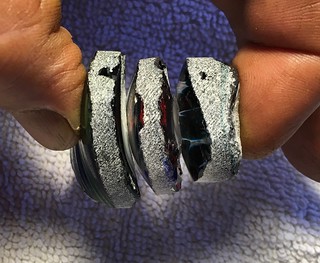 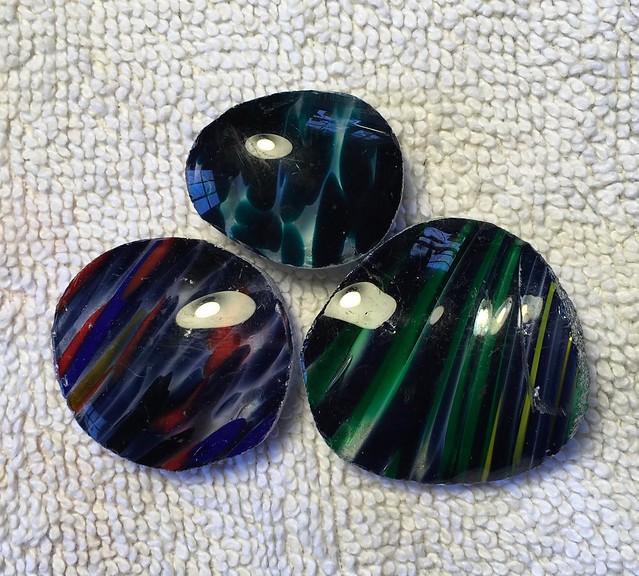 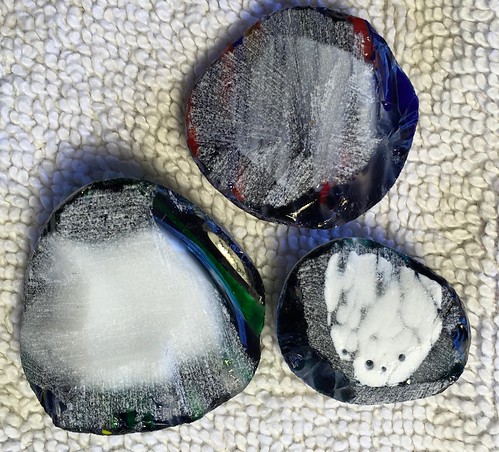 |
|
|
|
Post by MrP on Mar 2, 2018 10:09:41 GMT -5
The chips won't matter for heavy remelt for sure. I just know it sucks when I get close to a shape I want, then have chipping on the edge. I was thinking when you are setting the basal you will not want chips if you vibe tumble because large chips may show......................MrP
|
|
Tommy
Administrator 
Member since January 2013
Posts: 12,993
|
Post by Tommy on Mar 2, 2018 10:25:33 GMT -5
Tommy still in bed snoring. I do NOT snore...  Well, maybe a little when I forget to wear my nose strip. Sounds like you're in good hands here - thanks Chuck and others. To be honest a lot of this might be above my pay grade. This was my first venture into flat lapping and it's definitely been a learn as you go operation. I do have one of these in use but it had already been retrofitted with a slow RPM gearbox motor and I use it dry with a polishing pad for when I need that extra ummpf to coax out a stubborn shine.  |
|
|
|
Post by woodman on Mar 2, 2018 10:45:36 GMT -5
Looks real good in operation, but that said, I would slow it down a lot. also reduce the water drip or just stick with the spray bottle. all the extra water is doing is flushing the grit off of the plate. I got a 8 inch ameriatech that would work great for doing what you are doing.
|
|
jamesp
Cave Dweller 
Member since October 2012
Posts: 36,612
|
Post by jamesp on Mar 2, 2018 13:45:07 GMT -5
Tommy still in bed snoring. I do NOT snore...  Well, maybe a little when I forget to wear my nose strip. Sounds like you're in good hands here - thanks Chuck and others. To be honest a lot of this might be above my pay grade. This was my first venture into flat lapping and it's definitely been a learn as you go operation. I do have one of these in use but it had already been retrofitted with a slow RPM gearbox motor and I use it dry with a polishing pad for when I need that extra ummpf to coax out a stubborn shine.  Thanks Tommy. Mention to the Ms.' that a bop on the head with cast iron works better than aluminum frying pans to slow the snoring issues. Great build, like that foot operated gas peddle. |
|